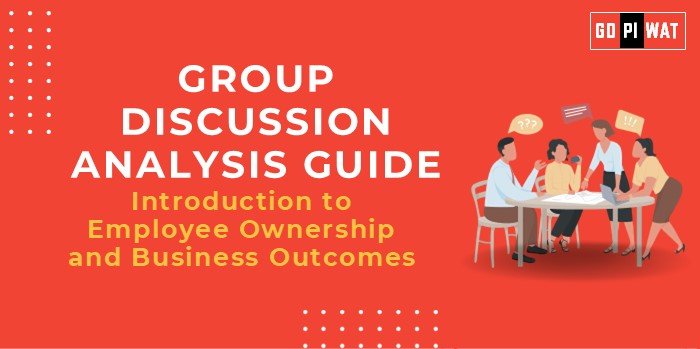📋 Group Discussion (GD) Analysis Guide: Introduction to Employee Ownership and Business Outcomes
🌟 Introduction to the Topic
Opening Context: Employee ownership has emerged as a significant trend in corporate governance and management. Globally, companies like John Lewis Partnership in the UK and Publix in the US have adopted this model to foster innovation, loyalty, and improved performance.
Topic Background: The concept of employee ownership involves giving workers partial or complete ownership in a company, often through stock options or cooperative structures. This approach aims to align employee interests with organizational goals, enhancing productivity and morale.
Recent Developments: The popularity of Employee Stock Ownership Plans (ESOPs) has grown worldwide, with over 14 million workers in the US alone benefiting from such schemes.
📊 Quick Facts and Key Statistics
- 📈 ESOP Participants in the US: Over 14 million employees (2023) – Reflects growing adoption of employee-centric ownership models.
- 🏢 Employee-Owned Firms in the UK: Over 800 firms, employing 200,000+ people – Demonstrates the scalability of this model.
- 💰 Impact on Revenue: Employee-owned firms reported a 25% higher year-on-year growth rate globally (Harvard Business Review, 2023).
- 🔁 Turnover Rates: Employee-owned companies saw a 50% reduction in voluntary attrition (National Center for Employee Ownership, 2023).
🤝 Stakeholders and Their Roles
- 👥 Employees: Owners and beneficiaries, driving the model’s success through active participation.
- 🏢 Companies: Implementers of ESOPs or cooperative structures.
- 🏛️ Governments: Regulators and incentivizers, often providing tax benefits for employee-owned models.
- 💼 Financial Institutions: Lenders or equity providers facilitating ownership transitions.
🏆 Achievements and Challenges
✨ Achievements:
- ✅ Improved Retention: Employee-owned companies reported 50% lower attrition rates.
- 📈 Higher Productivity: A study by NCEO (2023) shows productivity gains of up to 20% in firms with shared ownership.
- 💹 Greater Financial Performance: Revenue growth rates 25% higher than traditionally owned firms.
- 😊 Enhanced Employee Satisfaction: Surveys indicate an 85% employee satisfaction rate in such companies.
⚠️ Challenges:
- 💸 Initial Funding Needs: High cost of setting up ownership structures.
- 📊 Governance Issues: Balancing employee voices and managerial decision-making.
- 🔄 Scalability Concerns: Limited effectiveness in industries with high capital needs.
🌍 Global Comparisons:
- 🌟 Success: Mondragon Corporation (Spain) – A cooperative with over 80,000 employees, illustrating the scalability of employee ownership.
- ⚠️ Challenges: Limited adoption in high-tech sectors, often due to complex intellectual property and equity distribution issues.
📌 Case Studies:
- 🏆 John Lewis Partnership (UK): Renowned for its long-standing employee ownership model, showing resilience and profitability even during economic downturns.
- 🌟 Zingerman’s Community (USA): Exemplifies how shared ownership leads to community-driven business success.
📄 Structured Arguments for Discussion
- 🟢 Supporting Stance: “Employee ownership aligns individual and corporate goals, fostering loyalty, productivity, and profitability.”
- 🔴 Opposing Stance: “The financial burden and governance complexities of employee ownership often outweigh its benefits, particularly for small businesses.”
- ⚖️ Balanced Perspective: “While employee ownership has transformative potential, its success depends on careful implementation and sector-specific adaptation.”
🚀 Effective Discussion Approaches
🔑 Opening Approaches:
- 📈 “Employee-owned companies report 25% higher growth…”
- 📌 “The success of John Lewis Partnership demonstrates…”
🤔 Counter-Argument Handling:
1. Acknowledge costs but argue for long-term benefits: “While setup costs are high, studies show sustained profitability.”
2. Address governance challenges by citing best practices: “Clear governance models like those at Mondragon mitigate such issues.”
📈 Strategic Analysis of Strengths and Weaknesses
- 💪 Strengths: High employee engagement, enhanced brand loyalty, potential for innovation through collective ownership.
- ⚠️ Weaknesses: Initial setup complexity, potential conflicts in decision-making.
- 💡 Opportunities: Government incentives, global interest in sustainable business practices.
- 🚧 Threats: Resistance from traditional management, economic downturns impacting shared ownership returns.
📚 Connecting with B-School Applications
Real-World Applications: Employee ownership can inform topics like organizational behavior, financial planning, and corporate governance.
📌 Sample Interview Questions:
- ❓ “Can employee ownership models be integrated into startups?”
- 🌟 “How does employee ownership impact innovation in competitive industries?”
Insights for B-School Students:
- Evaluate ESOPs for management case studies.
- Analyze their financial implications in corporate finance.
- Propose scalable governance models as part of strategic projects.


